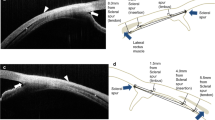Abstract
Purpose
The aim of the study was to determine the corneal limbus–extraocular muscle insertion distance (LID), via anterior segment optical coherence tomography, in healthy children and healthy adults and to compare the results of the measurements of the two groups.
Methods
Muscle limbus distances were measured using AS-OCT in 60 healthy cases in two groups. Children aged 8–13 years were evaluated as group 1, and healthy adults aged 25–30 years were evaluated as group 2. Measurements of 120 horizontal muscles were taken by one doctor (OBO). The values were compared according to age and gender groups, and correlation between LID measurements and spherical equivalent. Statistical evaluation was performed using SPSS 16® for Windows with the Student’s t test and Pearson correlation coefficient test.
Results
LID measurements for MR and for lateral rectus (LR) were 5.74 ± 0.75 and 6.74 ± 1.11 mm, in the pediatric age-group, and 5.73 ± 0.75 and 6.84 ± 1.15 mm, in the adult age-group, respectively. There was no statistically significant difference between the two groups in terms of MR distances. There was a slight increase in the adult values, for the LR distance. There was no significant difference in terms of gender. Correlation was found 0.62 for MR and 0.46 for LR between LID measurements and spherical equivalent in the pediatric age-group.
Conclusions
In healthy individuals, different imaging modalities can be used to measure LID, but AS-OCT can be used in pediatric age-groups as a preferred imaging method because it is easy and noninvasive.



Similar content being viewed by others
References
Lai YH, Wu WC, Wang HZ, Hsu HT (2012) Extraocular muscle insertion positions and outcomes of strabismus surgery: correlation analysis and anatomical comparison of Western and Chinese populations. Br J Ophthalmol 96:679–682
Ozgen A, Ariyurek M (1998) Normative measurements of orbital structures using CT. AJR Am J Roentgenol 170:1093–1096
Demer JL, Kerman BM (1994) Comparison of standardized echography with magnetic resonance imaging to measure extraocular muscle size. Am J Ophthalmol 118:351–361
Dai S, Kraft SP, Smith DR, Buncic JR (2006) Ultrasound biomicroscopy in strabismus reoperations. J AAPOS 10:202–205
Khan HA, Smith DR, Kraft SP (2012) Localising rectus muscle insertions using high frequency wide-field ultrasound biomicroscopy. Br J Ophthalmol 96:683–687
Liu X, Wang F, Xiao Y, Ye X, Hou L (2011) Measurement of the limbus-insertion distance in adult strabismus patients with anterior segment optical coherence tomography. Investig Ophthalmol Vis Sci 52:8370–8373
Park KA, Lee JY, Oh SY (2014) Reproducibility of horizontal extraocular muscle insertion distance in anterior segment optical coherence tomography and the effect of head position. J AAPOS 18:15–20
Salcedo-Villanueva G, Paciuc-Beja M, Harasawa M, Velez-Montoya R, Olson JL, Oliver SC, Mandava N, Quiroz-Mercado H (2015) Identification and biometry of horizontal extraocular muscle tendons using optical coherence tomography. Graefes Arch Clin Exp Ophthalmol 253:477–485
Ngo CS, Smith D, Kraft SP (2015) The accuracy of anterior segment optical coherence tomography (AS-OCT) in localizing extraocular rectus muscles insertions. J AAPOS 19:233–236
Pihlblad MS, Erenler F, Sharma A, Manchandia A, Reynolds JD (2016) Anterior segment optical coherence tomography of the horizontal and vertical extraocular muscles with measurement of the insertion to limbus distance. J Pediatr Ophthalmol Strabismus 53:141–145
Rosseto JD, Cavuoto KM, Allemann N, McKeown CA, Capó H (2017) Accuracy of optical coherence tomography measurements of rectus muscle insertions in adult patients undergoing strabismus surgery. Am J Ophthalmol 176:236–243
Faul F, Erdfelder E, Buchner A, Lang AG (2009) Statistical power analyses using G*Power 3.1: tests for correlation and regression analyses. Behav Res Methods 41:1149–1160
Athavale S, Kotgirwar S, Lalwani R (2015) Rectus and oblique muscles of eyeball: a morphometric study of Indian population. Anat Cell Biol 48:201–204
Blake CR, Lai WW, Edward DP (2003) Racial and ethnic differences in ocular anatomy. Int Ophthalmol Clin 43:9–25
Ettl A, Kramer J, Daxer A, Koornneef L (1997) High-resolution magnetic resonance imaging of the normal extraocular musculature. Eye (Lond) 11:793–797
Solarte CE, Smith DR, Buncic JR, Tehrani NN, Kraft SP (2008) Evaluation of vertical rectus muscles using ultrasound biomicroscopy. J AAPOS 12:128–131
Souza-Dias C, Prieto-Díaz J, Uesugui CF (1986) Topographical aspects of the insertions of the extraocular muscles. J Pediatr Ophthalmol Strabismus 23:183–189
De-Pablo-Gómez-de-Liaño L, Fernández-Vigo JI, Ventura-Abreu N, Morales-Fernández L, Fernández-Pérez C, García-Feijóo J, Gómez-de-Liaño R (2016) Spectral domain optical coherence tomography to assess the insertion of extraocular rectus muscles. J AAPOS 20:201–205
Authors’ contributions
OBO, AI, and BG were involved in conception and design. IY, EDA, and SC collected the data. OBO, AI, SYO, and MT performed the analysis and interpretation.
Author information
Authors and Affiliations
Corresponding author
Ethics declarations
Conflict of interest
The authors declare that they have no conflict of interest.
Ethical standard
All procedures performed in studies involving human participants were in accordance with the ethical standards of the institutional and/or national research committee and with the 1964 Declaration of Helsinki and its later amendments or comparable ethical standards. For this type of study, formal consent is not required.
Human and animal rights
This article does not contain any studies with human participants or animals performed by any of the authors.
Informed consent
Informed consent was obtained from all individual participants included in the study.
Rights and permissions
About this article
Cite this article
Ocak, O.B., İnal, A., Yilmaz, İ. et al. Measurement of extraocular horizontal muscle insertion distance via anterior segment optical coherence tomography of healthy children and comparison with healthy adults. Int Ophthalmol 39, 1037–1042 (2019). https://doi.org/10.1007/s10792-018-0903-5
Received:
Accepted:
Published:
Issue Date:
DOI: https://doi.org/10.1007/s10792-018-0903-5




